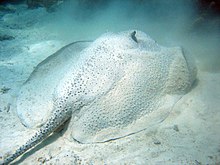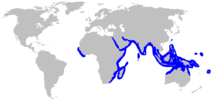Porcupine ray
| Porcupine ray | |
|---|---|

| |
| Scientific classification | |
| Domain: | Eukaryota |
| Kingdom: | Animalia |
| Phylum: | Chordata |
| Class: | Chondrichthyes |
| Subclass: | Elasmobranchii |
| Superorder: | Batoidea |
| Order: | Myliobatiformes |
| Family: | Dasyatidae |
| Genus: | Urogymnus |
| Species: | U. asperrimus
|
| Binomial name | |
| Urogymnus asperrimus (
J. G. Schneider , 1801) | |

| |
| Range of the porcupine ray[2] | |
| Synonyms | |
| |
The porcupine ray (Urogymnus asperrimus) is a rare
The diet of the porcupine ray consists mainly of
Taxonomy

German naturalists
In 1837,
Other common names for this species include black spotted ray, rough-skinned ray, roughback stingaree, Solander's ray, and thorny ray.[9] More than one species of porcupine ray may exist, as is currently recognized.[10]
Distribution and habitat

The porcupine ray is widely distributed, but uncommon compared to other stingrays that share its range. It is found all along the continental periphery of the
Description

The
The
Biology and ecology

The porcupine ray can sometimes be observed lying still on the bottom in the open or inside caves.
Human interactions

Despite not having a sting, the porcupine ray is capable of injuring humans with its many sharp thorns.
Presently, the porcupine ray is
References
- ^ . Retrieved 15 November 2021.
- ^ ISBN 978-0-674-03411-2.
- ^ Bloch, M.E.; Schneider, J.G. (1801). Systema Ichthyologiae iconibus cx illustratum. Berolini: Sumtibus auctoris impressum et Bibliopolio Sanderiano commissum. p. 367.
- ^ asperrima, Raja Archived 2012-03-19 at the Wayback Machine in: Eschmeyer, W.N.; Fricke, R., eds. Catalog of Fishes electronic version (29 March 2011).
- ^ ISBN 978-0-8248-1895-1.
- ^ Urogymnus Archived 2012-03-19 at the Wayback Machine in: Eschmeyer, W.N.; Fricke, R., eds. Catalog of Fishes electronic version (29 March 2011).
- ^ Hunter, R. (1895). Lloyd's Encyclopædic Dictionary. p. 387.
- PMID 27470808.
- ^ a b c d e f Froese, Rainer; Pauly, Daniel (eds.) (2011). "Urogymnus asperrimus" in FishBase. April 2011 version.
- ^ ISBN 978-1-86872-890-9.
- ISBN 978-3-925919-33-6.
- ^ ISBN 978-92-5-105045-3.
- ^ ISBN 978-0-8248-1808-1.
- ^ ISBN 978-92-5-104302-8.
- S2CID 23529337.
- .
- PMID 19391329.
- ISBN 978-1-4200-8047-6.
- ISBN 978-0-930118-18-1.
- ISBN 978-0-486-40726-5.
- ^ ISBN 978-0-00-715097-7.
- ^ Sterndale, R.A.; Aitken, E.H., eds. (1887). Journal of the Bombay Natural History Society, Volume 2. Bombay Natural History Society. p. 154.
- ^ Kingsley, J.S. (1888). The Riverside Natural History. Kegan Paul, Trench. p. 89.
- ^ Waite, E.R. (1900). "The Mammals, Reptiles, and Fishes of Funafuti". Memoir III – Australian Museum, Sydney – The Atolls of Funafuti, Ellice Group: Its Zoology, Botany, Ethnology, and General Structure. The Trustees. pp. 165–202.
- ISBN 978-2-8317-0700-6.
External links
- Photos of Porcupine ray on Sealife Collection
- Porcupine Ray @ Fishes of Australia

